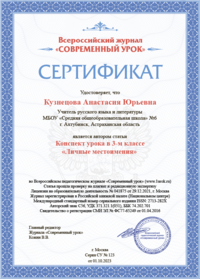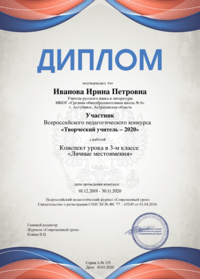Интегрированный урок английский язык и биология по теме «Генетика»
Автор: Шестакова Светлана Юрьевна
Организация: МШЗД
Населенный пункт: г. Москва
Тип урока: интегрированный урок обобщения и систематизации знаний
Цель урока: закрепление изученного материала в устной и письменной речи.
Задачи урока:
Образовательные
- Систематизировать знания по теме «Генетика»
- Учить использовать результаты проектной деятельности
- Расширить кругозор учащихся, знакомить с новейшими достижениями в молекулярной биологии
- Познакомить учащихся с Нобелевскими лауреатами в области Генетика
- Обобщить грамматический материал по теме «Словообразование»
Развивающие
- Развивать умение работать с научно-публицистическими текстами
- Развивать коммуникативные умения учащихся
- Развивать различные стратегии чтения при работе с текстами научного характера
Воспитательные
- Воспитывать умение слушать и слышать собеседника
- Воспитывать интерес к научной деятельности
- Воспитывать чувство уважения к людям, совершившим открытие в науке
Практические
- Практиковать навыки различных видов чтения
- Развивать навыки восприятия на слух аутентичной английской речи
- Практиковать использование грамматического материала по теме «Словообразование» в формате ЕГЭ
Ход урока
- Introduction
It was April 1953 that made a start on the development of the Molecular Biology which is still going on. It is a particular date in the history of the world science, because on that day DNA molecule was discovered, and since that moment Biology as a science has turned over a new page in its development. Why did the discovery of the only molecule DNA, just double helix structure, become a turning point in Biology and lead to great changes in this field?
By the beginning of 1950-s, it had been already known that genetic information existed on each strand of DNA in all living organisms, and transferred inherited information. But although the structure of DNA showed how inheritance worked, it was not still known how DNA influenced the behavior of cells and it was unclear which way this heteropolymer, consisting of 4 different chains, could realize its 2 main functions, such as transferring information to the offspring and replicating information within the cells.
- The History of DNA
Everything in this world has its beginning. When and where were the first sprouts of a new science noticed? What do we know about it? Let’s have a look into the depths of DNA history and date back to 1865 when a Moravian monk, Gregor Mendel by name, from a small town of Austrian Empire after studying the nature of inheritance in plants published his work. You read this information in Biology PACE #1107, and now we will check your Homework.
Questions for discussion:
- What do you know about inherited traits?
- Did people know about these facts many years ago?
- If yes, how could they notice these facts?
- Why did they use their practical knowledge in their daily life?
The fact that living organism inherit traits from their parents has been used since prehistoric time to improve crop plants and animals through selective breeding. But the modern science of genetics began with the work of Gregor Mendel in mid-nineteenth century who observed that organism inherit traits via discrete units of inheritance, which are now called genes.
PPP. Slide 1. Portrait of Mendel
- Mendel studied the segregation of heritable traits in pea plants
- He was studying the trait for flower color
- Mendel noticed that the flowers of each pea were either purple or white, but never an intermediate between the two colors
- These observations of discrete inheritance and segregation are known as Mendel’s first law or the Law of Segregation
Of cause, Gregor Mendel was not the only person who had been interested in such things, there were a lot of his followers who had studied his works and made their own discoveries. But before coming across dates and experiments connecting with this great discovery, let’s touch upon some important scientific definitions that will help us to understand the way of discovery itself better.
APPENDIX 1
Match the words (1-10) in the column on the left with their definitions (A-J) on the right.
|
A)______is an organized of DNA and protein that is found in cells. It is a single piece of coiled DNA containing many genes, regulatory elements and other nucleotide sequences. B)______in the field of Biology and Genetics that studies the structure and function of genes at a molecular level. The field studies how genes are transferred from generation to generation. C)_______is the passing of traits to offspring (from its parent or ancestors) D)______ is a biologically important type of molecule that consists of a long chain of nucleotide units. It is very similar to DNA, but differs in a few important structural details. E)_____are molecules that, when joined together, make up the structural units of RNA and DNA. F)______in modern molecular Biology and Genetics it is the entirety of an organism’s hereditary information. G) _____biodiversity, genetic diversity, difference within a species H)_______is a change in a genomic sequence: the DNA sequence of a cell’s genome or the DNA or RNA sequence of a virus. I)________is a set of primary tenets relating to the transmission of heredity characteristics from parent organisms to their offspring. J)_____is the change in the inherited traits of a population of organism through successive generations. |
Keys:
1-E 6-F
2-G 7-C
3-J 8-H
4-I 9-B
5-A 10-D
PPP Slide 2. Portrait of Miescher
Some years later, after Gregory Mendel’s discovery, in 1869 at the laboratory of one of the German Universities, another scientist Johann Friedrich Miescher, a Swiss physician and biologist isolated various phosphate-rich chemicals, which at first he called nuclei (now nucleic acids) paving the way for identification of DNA as the carrier of inheritance. A bit later, when Miescher discovered that nuclei possessed acid properties he gave it the name nuclear acid. Miescher and his students researched much of the nucleic acid chemistry, but their function remained unknown for a long time. The significance of the discovery first published in 1871 was not at first appreciated, as the biological function of this new substance was not clear and not for a long time, DNA was considered to be a sore of phosphorous in a living organism. Moreover, even at the beginning of the XX century many biologists believed that DNA had nothing in connection with inheritance, because according to them, DNA had been too monotonous and had not been able to contain coded information. However, Miescher’s discovery played an important part in identification of nucleic acid as the carries on inheritance, and only thanks to another German scientist the research was carried out on the chemical structure of nuclei.
Let’s investigate Johann Friedrich Miescher’s biography.
APPENDIX 2
Read attentively the sentences and choose the correct word out of the chain of words in each sentence to make up the text.
- Johann Friedrich Miescher, a Swiss physician and biologist isolated different/various/numerous phosphate-rich chemicals, which he called nuclei.
- Miescher and his students researched/examined/learned the nucleic acid chemistry a lot.
- But the function of this new substance was not fair/clear/distant for a long time.
- Even at the beginning of the XX century many biologists believed that DNA had nothing in connection with the inheritance/heritage/heir of some properties.
- However, Miescher’s discovery helped another scholar/scientist/educator to carry out on the chemical structure of the nuclei.
Keys:
- Various
- Researched
- Clear
- Inheritance
- Scientist
РРР. Slide 3. Portraits of Francis Crick, Rosalind Franklin, Maurice Wilkins, James D. Watson
The XX century brought us the other brilliant names of the scientists who had been working in this field. This list of names is too long even for the simple mention, but we have to recollect some of them, whose discoveries were the most prominent.
Your Homework was to prepare an Oral report about them and now we are going to listen to them.
Presentations by students.
I would like to add some more information for you about these famous scientists.
APPENDIX 3
Read this text and fill in the blanks with the correct form of the words.
|
Francis Crick was a British molecular________, physicist, and neuroscientist. He is known as one of two________ of the structure of the DNA molecule. In 1953, basing on X-rayed structure analysis made by Maurice Wilkins, he and James D. Watson _________the famous DNA double spiral. It was a _________ discovery, because the model explained the process of reproduction of DNA molecules and the principle of keeping and carrying the inherited______. In 1962 Francis Crick together with Maurice Wilkins and James Watson were jointly awarded Nobel Prize for Medicine for their ______concerning the molecular structure of nuclear acids and its significance for _____ transfer in living material. |
BIOLOGY
DISCOVER
DESIGN WONDER
INFORM
DISCOVER
INFORM |
Conclusion.
Well, I won’t be mistaken if I say that DNA is really the main molecule of life. Life goes on and new generations of scientists that are keen on molecular biology make their research nowadays. Gene therapy is still in its infancy, but this technology has been used with some success to treat disease, such as cancer. May be one day some of you will discover new aspects of this fantastic molecule.
Материалы учебных пособий:
- Эванс В., Дули Д., Афанасьева О.В., Михеева И.В. «Английский в фокусе» Sportlight. 11 класс. Просвещение, 2021
- Biology 1107. Accelerated Christian Education, Inc.2021
- Genny Dooley, Virginia Evans “Exam Booster”. Express Publishing, 2021
- Материалы сайтов www.wikipedia.org, www.biozoo.ru, www.naturalworld.ru






